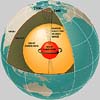| . |  |
. |
New Brunswick NJ (SPX) Nov 30, 2006 A geologist at Rutgers, The State University of New Jersey, has come up with evidence our planet practices recycling on a grand scale. Writing in the prestigious British science journal Nature, geological sciences professor Claude Herzberg offers new evidence that parts of the Earth's crust that long ago dove hundreds or thousands of kilometers into the Earth's interior have resurfaced in the hot lava flow of Hawaiian volcanoes. "This concept has been a big issue in the earth sciences," Herzberg said. While it had been proposed earlier by some geologists, the profession hasn't embraced it because evidence until now remained sketchy. "Many geologists felt that when Earth's crust was forced deep into the mantle, a process called subduction, it would simply stay there." Herzberg claims to have found telltale chemical evidence at Mauna Kea that pieces of this submerged crust have been forced up through plumes and now make up most of this volcano's lava flow. "The low calcium in the Hawaiian magma pegs it as crust that had melted and been forced to the surface," he said. The calcium levels in traditional magma, which comes from melting the Earth's mantle layer below the crust, are much higher. Herzberg said his research doesn't stop in Hawaii and that his chemical findings will be useful in understanding the makeup and action of other volcanoes around the world. These findings extend beyond calcium and include sulfur, along with isotopes of the heavier elements hafnium and lead that are tracers for clays and other materials that originated close to the surface prior to subduction. "Chemical patterns we've found elsewhere used to be puzzles but are now starting to make sense," he said. Still, the big island of Hawaii remains the prime site for uncovering the secrets of volcanic action, as it has the largest volcanoes on Earth and is the most productive in terms of lava outpouring. Herzberg believes the information he's uncovered about magma chemistry might one day help scientists predict eruptions, as different chemical abundances show up at different times in the volcanoes' eruption cycles. Related Links Rutgers, the State University of New Jersey When the Earth Quakes  Fairbanks AL (SPX) Nov 29, 2006
Fairbanks AL (SPX) Nov 29, 2006The work of a University of Alaska Fairbanks post-doctoral fellow will be included in an article appearing in the upcoming issue of the journal, Science. The article reveals that scientists are now able to directly measure heat that moves from the molten metal of Earth's core into a region at the base of the mantle, a boundary located halfway to Earth's center, about 1,740 miles deep. |
|
| The content herein, unless otherwise known to be public domain, are Copyright 1995-2006 - SpaceDaily.AFP and UPI Wire Stories are copyright Agence France-Presse and United Press International. ESA PortalReports are copyright European Space Agency. All NASA sourced material is public domain. Additionalcopyrights may apply in whole or part to other bona fide parties. Advertising does not imply endorsement,agreement or approval of any opinions, statements or information provided by SpaceDaily on any Web page published or hosted by SpaceDaily. Privacy Statement |